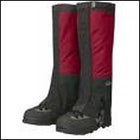Gaiters are indeed a necessary piece of equipment, Matt. I regard them as necessary just about the year around.
 The Crocodile Gaiter
The Crocodile GaiterIn essence, gaiters are simply fabric tubes, open on one side and fastened with hook-and-loop fasteners or something similar, and held in place with a strap that runs under the boot. They聮re sort of a modern take on puttees, the fabric strips wrapped around boot tops and calves by members of the U.S. military up until World War II.
For our purposes, gaiters mainly prevent stuff from getting down your boot tops. Snow is the chief offender here, so gaiters are most often sold for that purpose. But during the dry months gaiters can keep gravel, dirt, weed burrs, and other material out of your footwear.
Gaiters aren聮t exotic, and it聮s difficult to improve on the basic design. It must have been two decades ago that came out with the Gore-Tex Crocodile ($65) and they now probably have 80 percent of the market. “Crocs” are well-made, practical, and about all you need in a gaiter. ‘s GTX FrontPoint gaiters ($80) are designed for ice climbers聴they聮re cut a little higher so the gaiters don聮t interfere with crampons. ‘s Pinnacle Stretch Gaiter ($70) is designed for plastic boots and is primarily a big-mountain or expedition gaiter.
For summer use, ‘s Desert Gaiters ($25) are light and breathable, just the thing for warm-weather hiking.
Fit matters with gaiters. Get whatever just fits your boot, not ones that are too large. That helps ensure they fit snugly so snow doesn聮t get jammed up inside of them. A close fit also ensures they don聮t blouse out and snag on crampons, if you are using them on snow or ice. Then again, snagging gaiters on crampons is pretty much inevitable.
Breaking the straps that go under the boot is inevitable, too. They take a lot of abuse from rocks, ice, and other stuff that abrades and cuts them. No big deal. Most gaiters are made with easily replaceable straps. Or they have metal eyelets on each side and you can use any kind of cord you wish for a strap.


